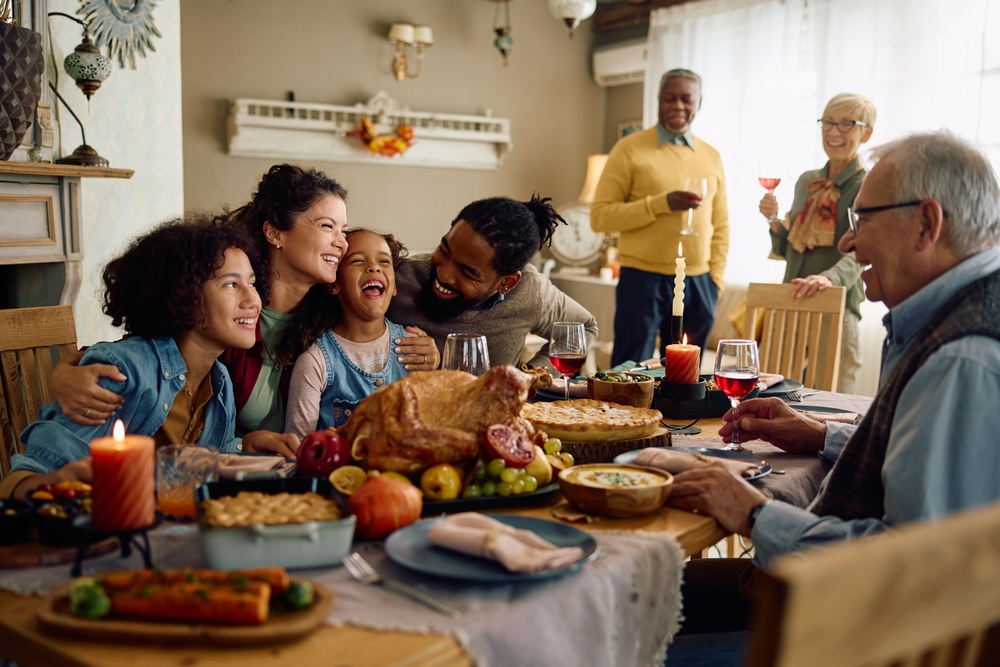
Thanksgiving planning is no mean feat. Like any other occasion, it has its own logistics and practicalities, yet Turkey Day is a banquet of epic proportions, a cornucopia of endless culinary iterations (you’re either Team Apple Pie or Team Pumpkin Pie, OK?) and often — as any gathering of family and friends is wont to be — a feast of deep and rich emotions.
Bearing in mind the complexities of the day — the large and sometimes disparate guest list, your diners’ multiple dietary requirements, the obsession with perfect timing, the endless simmering (of both gravy and feuds) — we at Eventsforce wondered what it would be like if we applied some of the planning tactics familiar to every event professional to organise and pull off a perfect Thanksgiving. So without further ado — and because every Thanksgiving chef is well and truly a planner at heart — this is your perfect Turkey Day, portioned out, plated up and served with efficiency thanks to the power of professional event planning.
-
Define the Day and Choose the Date — With Care
A thoughtful host and a careful planner begins by naming and defining the purpose of their occasion. For many Americans and those around the globe with a broad awareness of American culture, Thanksgiving speaks for itself. However, there are many for whom the day is entirely foreign; bear this in mind and be prepared to describe the holiday to give context to anyone not familiar with Thanksgiving festivities. In the US and its territories, Thanksgiving is celebrated on the fourth Thursday of November, which is a public holiday. As those marking the day overseas well know, Thanksgiving is not observed internationally and so you’ll want to schedule your feast for a weekend and/or a time appropriate to the surrounding culture (i.e., avoiding local days of religious observance, etc.).
-
Pause and Prep for effective Thanksgiving planning
What’s a planner without a schedule? In terms of overall preparation, a savvy Thanksgiving host begins their initial preparations approximately a month to three weeks out from the big day. Here’s a rough timeline for your Thanksgiving preparations; feel free to add in your own points and adjust, as needed:
- 1 month to three weeks before: know your budget, select your date, have a rough estimate for guest figures, choose your venue
- Three to two weeks before: create a WhatsApp group/some kind of platform to communicate with guests, issue invites with RSVPs, set your menu, order turkey, verify freezer space for cooking ahead (see next point)
- One week before: ensure you have enough seating, cutlery, plates, glasses, mugs etc., for everyone in attendance, cook/freeze side dishes
- Three days to one day before: defrost turkey/pick-up fresh bird, check that your roasting tin is large enough and that your turkey and tin can fit in the oven, defrost your sides and create an on-the-day masterlist for cooking timings
- On the day: Cook and rest turkey, make your mash, bake rolls and heat through sides, gravy and pies
-
Selecting the Venue, Setting the Time
A professional event planner may have multiple venues up for consideration, but your home — with its familiar kitchen — is absolutely your best bet. There is nothing more disorienting than cooking Thanksgiving for a crowd in an unfamiliar kitchen. On that note, if you decide to use an alternative venue, do as any planner would do and familiarise yourself with the space ahead of time, making a note of where pots, pans, plates, dishes, cutlery and all utensils are stored. Test the oven to ensure that you know both how to adjust the temperature and also if it runs hotter or cooler than your appliance at home.
When you set your time for the occasion, take into account the intricacies of your menu (for example, a whole turkey takes much longer to cook than a crown), the schedules of your guests, the size of your oven and even things such as the nap schedules of smaller diners. HINT: when setting the time, suggest an early afternoon sitting to allow your guests to enjoy a leisurely meal, a point that also enables you to avoid cleaning up late into night.
-
Guess Who’s Coming to Dinner?
You might already have a reasonable idea of who you want to invite to your Thanksgiving feast, but it’s wise to firm things up with a more formal invite, issued via the platform most convenient to your guests. Unlike a professional planner, you won’t have a bespoke app at your disposal for the occasion, but consider setting up a WhatsApp group specifically for the day. After all, all you really want is a platform that will enable you to communicate with guests directly both in the run up to and on the day of your Thanksgiving feast.
Once you’ve issued invites — preferably with some kind of RSVP to enable you to move forward with a precise number of guests — you can use this forum to provide arrivals with information on points like transport options for getting to your venue and, if needed, details on parking.
-
Menu Madness with a side of Guest Engagement
Now is the time to plan your feast in earnest. With your platform set up, you can easily gather information on any dietary requirements. In keeping with convention, the traditional Thanksgiving feast is comprised of the following core dishes:
– Turkey
– Stuffing
– Mashed potatoes and gravy
– Cranberry sauce
– Green bean casserole
– Sweet potato casserole
– Dinner rolls
– Pumpkin OR apple pie
Depending on your personal custom, taste, diet and budget, you may not follow this exact menu and instead opt for a variation on these foods. But know that once invited, guests may offer to bring certain menu items. While this level of enthusiastic engagement certainly is the stuff of planners’ dreams, you should — as the person who is ultimately responsible for feeding your guests — consider these offers with care. After all, should someone volunteer to cook one of the above key items and then either forget their offer or be unable to attend on the day, this hole in the menu will create serious last-minute stress for you.
So, to any kind offers of help, you may want to ask volunteers to bring a dish or an item that — while perhaps not traditional to the Thanksgiving table (hello vegan quiche) — if forgotten or not made, won’t ruin your feast. With this diplomatic and discreet tactic, your guests are actively participating in the occasion, but you still have full control over this event in the culinary sense.
-
Maximise Time and Budget: Shop and Cook with Care
Like any other planner, you need to maximise your time and your budget and so it pays to carefully comb through your freezer, fridge and cupboards to see what you can use to shave both pennies and seconds off your pre-Thanksgiving shop. Take the time to walk back through your menu — down to the individual recipe ingredients — and try to incorporate what you already have in your cupboard into your meal — be it spices, tea or coffee, potatoes, onions or a few bottles of wine for the table. Anything you can find will help lessen the cost of your feast.
If, like many modern hosts, you find yourself cooking for guests with multiple dietary restrictions, you’d be wise to find a recipe that meets all requirements (rather than cooking multiple variations of a single recipe). For example, if you’re catering for vegetarians as well as those who are gluten and dairy-free, you can easily make a vegetarian gravy with cornflour that suits these requirements and still tastes absolutely delicious. Most importantly, if you work ahead, cranberry sauce, sweet potato and green bean casseroles, rolls, gravy, stuffing and pies can all be made in advance, frozen and then defrosted a day or so ahead of Thanksgiving to be heated through on the big day.
-
Find a (Sober) Second in Command to help with your Thanksgiving planning
Even with the best organisation and preparation, the frank truth of Thanksgiving is that you’ll still be spending a lot of the day in the kitchen. As the chef and chief organiser, you know your timings and what needs to be done exactly when and that’s why it pays to delegate any other tasks — be they cleaning, setting up, decorating, answering queries via your WhatsApp channel or greeting guests (and keeping them out of the kitchen!) to a trusted second in command. But before you do this, talk them through what you need and expect from them on the day because — just as with any other event — communication is absolutely key to the success of your Thanksgiving. Likewise, if you need and expect them to be stone cold sober for the day, be honest with them (and buy them a nice bottle of wine for later).
-
Handling Disagreements, No-Shows and Leftovers
The gravy’s not always the only thing that simmers on Thanksgiving and so — when it comes to handling familial disagreements and tensions — if you feel an assigned seating chart will help keep things civil, feel free to draw one up. Likewise, if you know that you can rely on your guests and your second in command to resolve any issues that might crop up, don’t worry about assigned seating. But if you are worried about any extra prickly guests or potentially awkward situations, speak to your number two to agree on a strategy to handle these so as not to impact the overall good vibes of your day.
Family tensions aside, the other things you can always rely on at Thanksgiving are no-shows and leftovers. Whether it’s down to illness or a scheduling conflict, it’s frustrating to realise that you may have over-catered your event. But if you are aware of no-shows even just a few hours in advance, you can always ask your guests to come with empty containers in hand, explaining that they’d be doing you a huge favour by taking some extra food home with them. You’ll find that many are only too happy to oblige and — what’s more — that this level of guest participation makes you look extra generous, all while cannily relieving you of the burden of leftovers.
-
No, Thank You!
Yes, of course your guests should be thanking you for your outstanding culinary efforts. But even if your Thanksgiving planning doesn’t quite go to plan (and what event does?), there’s nothing that adds an extra glow to the day like a gracious host. This is precisely why you need to deploy a final tried-and-trusted planning strategy and offer your thanks to your guests when the day is done. After all, they have given you their time, their attention and — of course — their willingness to eat sweet potatoes topped with marshmallows (hey, it’s not everyone’s cup of tea).
Indeed, by being a grateful host, you’re the living embodiment of everything that this unique day — whether you’ve celebrated it before or not — truly symbolises. And what’s more, by striking a gracious note, you — as the chef, the host and the planner — are setting exactly the right tone for next year’s feast and for all the good things yet to come.
Running live, virtual or hybrid events? Want to maiximise event success like you’ve done with your thanksgiving planning? Give your attendees an event experience they’ll remember with technology you can rely on. Learn how Eventsforce can make your next event fabulous and successful. Book your personalised demo now.







